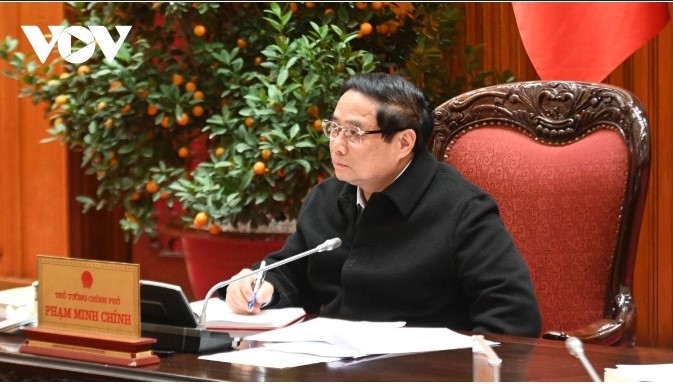Government restructuring to reduce intermediaries and improve efficiency, says PM
VOV.VN - Prime Minister Pham Minh Chinh has directed that the restructuring of the government apparatus should reduce intermediate steps and administrative units, while ensuring that there is no overlap or omission of functions, tasks, and powers.

Prime Minister Pham Minh Chinh chaired the ninth session of the Government Steering Committee on the implementation of Resolution No.18 of the 12th Party Central Committee on January 11 in Hanoi, with the goal of streamlining the organizational structure of the political system.
This session focused on discussing the progress and reporting on the implementation of the resolution and the proposed plan for restructuring and simplifying the government apparatus.
According to the Ministry of Home Affairs, all 30 ministries and sectors have officially submitted their reports on the implementation of Resolution No. 18 and proposed plans for organizational restructuring, along with draft decrees specifying the functions, tasks, powers, and organizational structure of the ministries.
The aim of these efforts is to enhance the functions, tasks, and organizational structure of the Government for the 15th term, ensuring a streamlined, efficient, and effective government based on rational organization of multi-sector and multi-field ministries, as well as fully utilizing the role and powers of the government as prescribed by the Constitution.
This will help build a democratic, professional, modern, transparent, and strong government that serves the people, while enhancing smooth governance from the central to local levels based on appropriate decentralization and delegation of authority, meeting the requirements for building and perfecting the socialist rule-of-law state of Vietnam.
The restructuring plan focuses on organizing ministries with a multi-sector, multi-field approach, ensuring that each task is assigned to one lead agency, avoiding overlap or gaps in responsibilities, and improving the effectiveness of state management. The plan also includes restructuring internal departments, aiming to reduce 15-20% of the organizational units within agencies not undergoing mergers, and 35-40% within agencies undergoing mergers.
The restructuring will be coupled with reducing the number of civil servants and public employees, aiming for a 20% reduction in civil servants receiving salaries from the state budget, in line with the policy on staffing when restructuring the political system. This will enhance the quality of government personnel, improve state management efficiency, and meet the demands of the new situation.
After listening to various opinions, PM Pham Minh Chinh concluded that each issue should be resolved separately and that there were differing views on certain ministries and agencies. He directed the Ministry of Home Affairs to continue reviewing, adjusting, and supplementing the plan as needed, ensuring that the organizational structure is streamlined, efficient, and effective, with a focus on reducing the number of intermediate steps, cutting down on redundancies, and not overlooking any functions, tasks, or powers.
The Government chief emphasized the difficulty of reorganizing the government structure and called on Steering Committee members to take responsibility, listen to the views of relevant ministries, and focus on executing the plan according to the required timeline and quality.
He underscored the importance of maintaining smooth operations and avoiding disruptions to services for the people and businesses. PM Chinh instructed the Ministry of Home Affairs and other agencies to incorporate feedback and continue refining the proposal and related documents for submission and approval by competent authorities.



